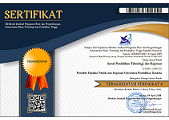FAKTOR PENGARUH MINAT MASUK PERGURUAN TINGGI DI SMK SERANG
DOI:
https://doi.org/10.23887/jptk-undiksha.v14i1.8656Abstract
Tujuan penelitian ini adalah mengetahui seberapa besar minat masuk perguruan tinggi bagi siswa kelas XII program keahlian Teknik Mesin dan Teknik Otomotif di SMK Serang masuk tahun 2016. Metode yang digunakan dalam penelitian ini adalah deskriptif kuantitatif. Sampel penelitian diambil dengan teknik Proportional Random Sampling sejumlah 165 siswa. Teknik pengumpulan data menggunakan angket (kuesioner). Uji validitas instrument dilakukan dengan construct validity melalui experts judgment dengan metode factor analysis. Uji reliabititas menggunakan Alpha. Besarnya minat diuji dengan statistic regresi ganda dengan bantuan SPSS versi 21. Hasil penelitian menunjukkan bahawa minat masuk perguruan tinggi di Serang dengan rerata persentase 71.76%. Minat tersebut dipengaruhi oleh faktor dalam diri sendiri, faktor lingkungan keluarga, dan faktor lingkungan sekolah dengan koefisien regresi masing-masing sebesar 0.199; 0.190; dan 0.090. Faktor diri sendiri dan lingkungan keluarga secara bersama-sama mempengaruhi minat masuk perguruan tinggi sebesar 37,6%.
Kata kunci: Minat, Perguruan Tinggi, Diri Sendiri, Sekolah, dan Keluarga
Downloads
Published
Issue
Section
License
Authors who publish with the JPTK agree to the following terms:- Authors retain copyright and grant the journal the right of first publication with the work simultaneously licensed under a Creative Commons Attribution License (CC BY-SA 4.0) that allows others to share the work with an acknowledgment of the work's authorship and initial publication in this journal
- Authors are able to enter into separate, additional contractual arrangements for the non-exclusive distribution of the journal's published version of the work (e.g., post it to an institutional repository or publish it in a book), with an acknowledgment of its initial publication in this journal.
- Authors are permitted and encouraged to post their work online (e.g., in institutional repositories or on their website) prior to and during the submission process, as it can lead to productive exchanges, as well as earlier and greater citation of published work. (See The Effect of Open Access)












